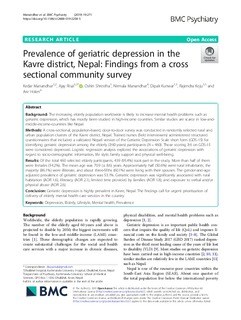| dc.contributor.author | Manandhar, Kedar | |
| dc.contributor.author | Risal, Ajay | |
| dc.contributor.author | Shrestha, Oshin | |
| dc.contributor.author | Manandhar, Nirmala | |
| dc.contributor.author | Kunwar, Dipak | |
| dc.contributor.author | Koju, Rajendra | |
| dc.contributor.author | Holen, Are | |
| dc.date.accessioned | 2020-02-18T10:14:47Z | |
| dc.date.available | 2020-02-18T10:14:47Z | |
| dc.date.created | 2019-11-07T17:01:03Z | |
| dc.date.issued | 2019 | |
| dc.identifier.issn | 1471-244X | |
| dc.identifier.uri | http://hdl.handle.net/11250/2642220 | |
| dc.description.abstract | Background
The increasing elderly population worldwide is likely to increase mental health problems such as geriatric depression, which has mostly been studied in high-income countries. Similar studies are scarce in low-and-middle-income-countries like Nepal.
Methods
A cross-sectional, population-based, door-to-door survey was conducted in randomly selected rural and urban population clusters of the Kavre district, Nepal. Trained nurses (field interviewers) administered structured questionnaires that included a validated Nepali version of the Geriatric Depression Scale short form (GDS-15) for identifying geriatric depression among the elderly (≥60 years) participants (N = 460). Those scoring ≥6 on GDS-15 were considered depressed. Logistic regression analysis explored the associations of geriatric depression with regard to socio-demographic information, life style, family support and physical well-being.
Results
Of the total 460 selected elderly participants, 439 (95.4%) took part in the study. More than half of them were females (54.2%). The mean age was 70.9 (± 8.6) years. Approximately half (50.6%) were rural inhabitants, the majority (86.1%) were illiterate, and about three-fifths (60.1%) were living with their spouses. The gender-and-age adjusted prevalence of geriatric depression was 53.1%. Geriatric depression was significantly associated with rural habitation (AOR 1.6), illiteracy (AOR 2.1), limited time provided by families (AOR 1.8), and exposure to verbal and/or physical abuse (AOR 2.6).
Conclusion
Geriatric depression is highly prevalent in Kavre, Nepal. The findings call for urgent prioritization of delivery of elderly mental health care services in the country. | nb_NO |
| dc.language.iso | eng | nb_NO |
| dc.publisher | BMC | nb_NO |
| dc.rights | Navngivelse 4.0 Internasjonal | * |
| dc.rights.uri | http://creativecommons.org/licenses/by/4.0/deed.no | * |
| dc.title | Prevalence of geriatric depression in the Kavre district, Nepal: Findings from a cross sectional community survey | nb_NO |
| dc.type | Journal article | nb_NO |
| dc.type | Peer reviewed | nb_NO |
| dc.description.version | publishedVersion | nb_NO |
| dc.source.volume | 19 | nb_NO |
| dc.source.journal | BMC Psychiatry | nb_NO |
| dc.source.issue | 1 | nb_NO |
| dc.identifier.doi | 10.1186/s12888-019-2258-5 | |
| dc.identifier.cristin | 1745063 | |
| dc.description.localcode | © 2019 The Authors. Open Access This article is distributed under the terms of the Creative Commons Attribution 4.0 International License (http://creativecommons.org/licenses/by/4.0/), which permits unrestricted use, distribution, and reproduction in any medium, provided you give appropriate credit to the original author(s) and the source, provide a link to the Creative Commons license, and indicate if changes were made. The Creative Commons Public Domain Dedication waiver (http://creativecommons.org/publicdomain/zero/1.0/) applies to the data made available in this article, unless otherwise stated. | nb_NO |
| cristin.unitcode | 194,65,35,0 | |
| cristin.unitname | Institutt for psykisk helse | |
| cristin.ispublished | true | |
| cristin.fulltext | original | |
| cristin.qualitycode | 1 | |

